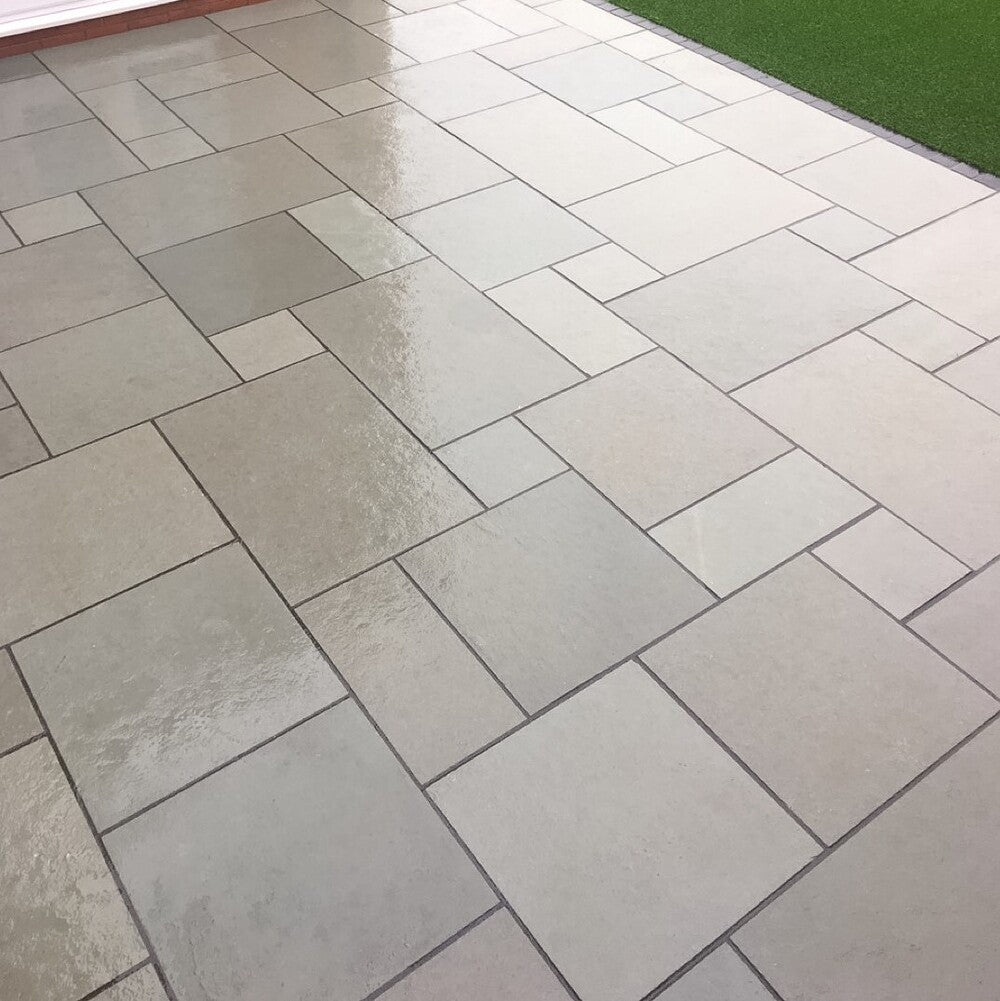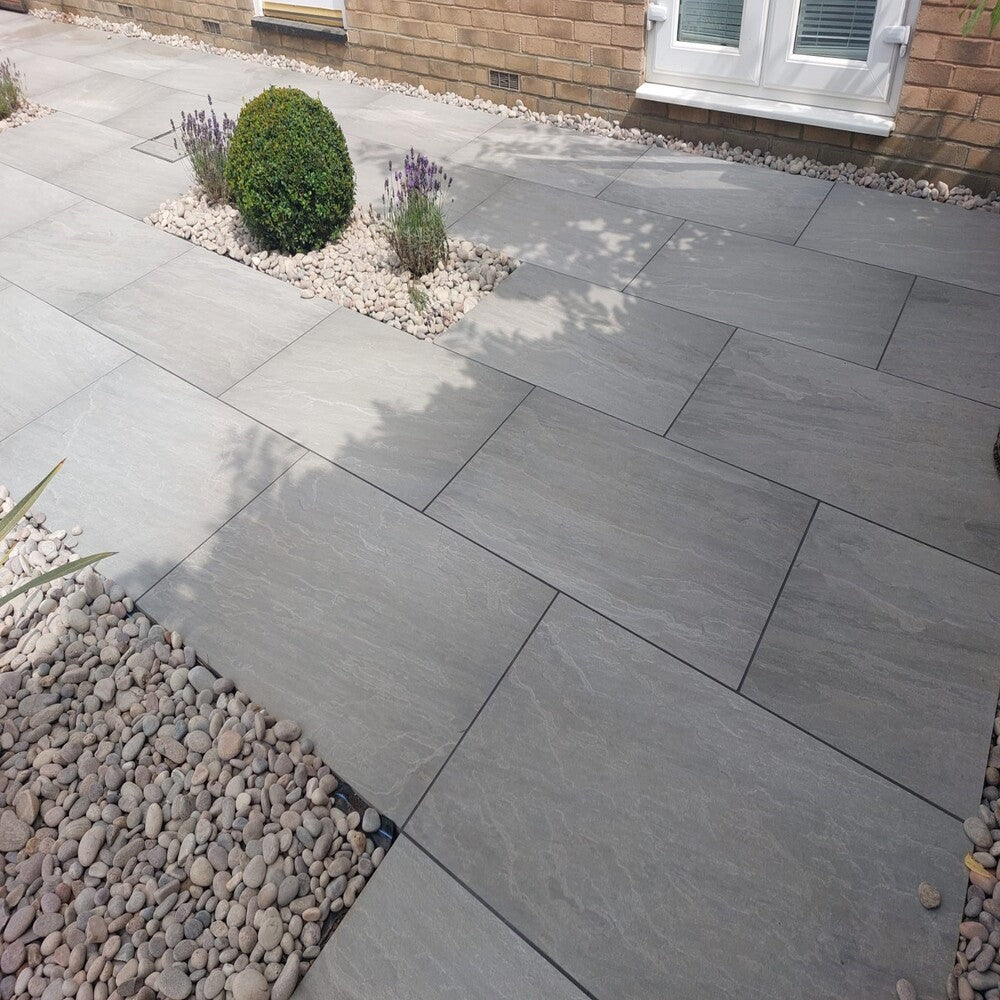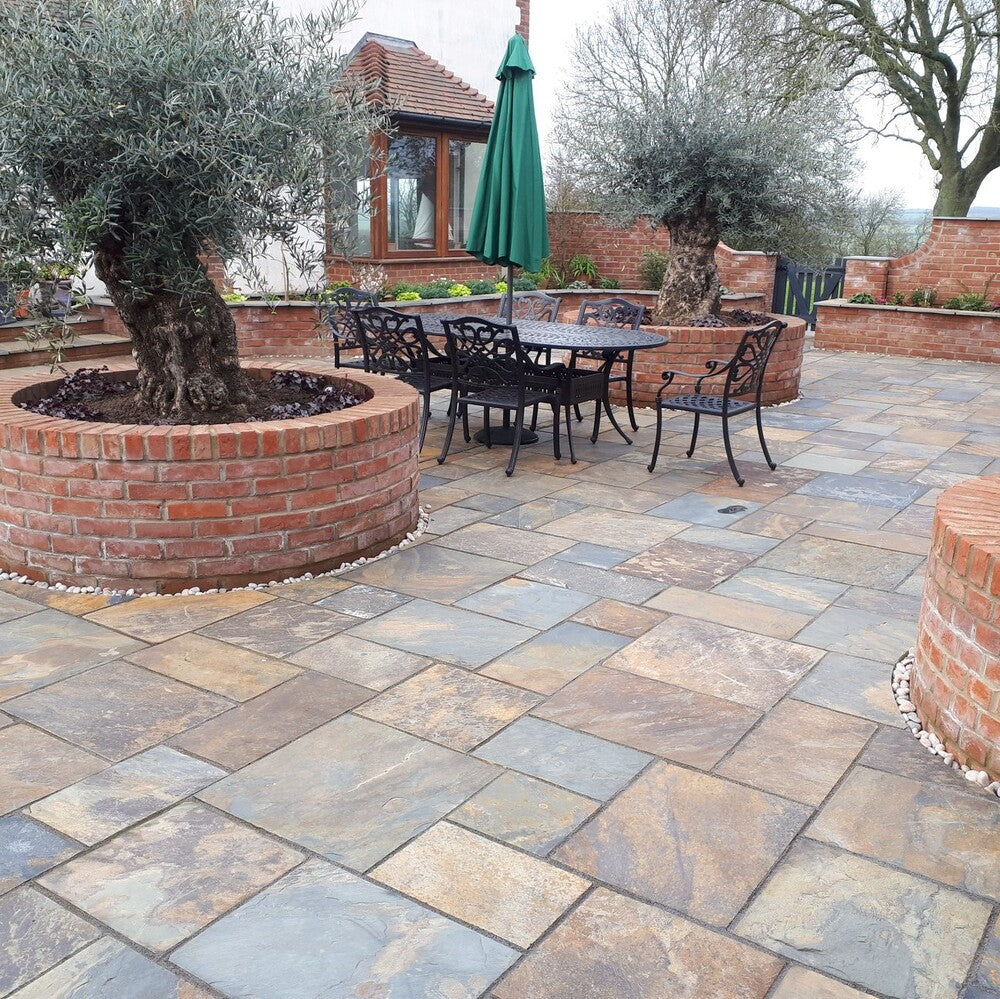Choosing the right patio or paving option for your garden can feel like a real challenge. From considering different materials to calculating costs and time frames, there is a lot to take into account. On top of that, finding the right team for the job can be tricky, especially considering the potential for weather, tool hire, and other unexpected complications.
In this blog post, we’ll take a comprehensive look at every cost involved in laying patios and paving, as well as the essential aspects of any patio or paving project.

Key Takeaways:
- Quality vs Cost: Achieving high quality in your patio or paving project often means balancing between affordability and excellence. Remember, cheaper isn't always better, especially when it comes to durability and appearance.
- Size and Material: The size of your patio directly impacts the cost due to the amount of material needed. Choosing the right material, be it natural stone or porcelain, will affect both the cost and the longevity of your patio.
- Location and Ground Conditions: Costs can vary significantly based on your location (urban vs rural) and the type of ground material beneath your patio. Different soil types may require extra work and materials for a stable foundation.
- DIY vs Professional Installation: Weigh the pros and cons of DIY installation versus hiring professionals. While DIY can save costs, professionals ensure accuracy and efficiency.
- Final Thoughts: Proper planning, understanding the costs involved, and choosing the right materials and professionals are crucial for a successful patio or paving project. Consider all factors to create a durable, beautiful outdoor space that aligns with your budget and lifestyle.
Key Considerations for Patio and Paving Projects:
-
Quality equals results. A low-quality 'professional' using substandard materials and with little attention to detail could result in a poorly built patio that won't withstand the test of time.
-
Quality has a price. There's good, there's cheap, and there's fast - but you generally can't have all three. It can be challenging to find excellent quality at a reasonable price.
-
The size matters. The costs and timescales for a patio or paving project scale with its size. Use our Patio Cost Calculator and Paving Slabs Calculator to understand the costs better.
Let’s now move on to six main factors influencing the cost of any patio or paving project:
- Location: For instance, laying a patio in Central London will cost significantly more than in Lincoln.
- Patio size: Bigger patios require more materials, increasing the cost.
- Slab choice: A more expensive slab typically lasts longer and provides a more esteemed finish.
- Underlying material: Different types of soil and clay can result in unique challenges and additional costs.
- Access to the area: Any access issues can result in additional costs or risks.
- Extras: Adding features like lighting, raised bedding, or steps will accrue extra costs.
We’ll also discuss the step-by-step process of laying a patio, considerations about the material and area, additional or unexpected costs, and the costs and challenges involved in a DIY job versus hiring professionals. We’ll also present a table with rough estimates of costs per square meter for professional installation, using different materials.

We hope that this article provides you with a clear understanding of the various considerations and costs associated with laying patios and paving. With careful planning and the right team, you can create a beautiful and lasting outdoor space.
Understanding the Key Factors That Influence Patio and Paving Costs
As we venture deeper into the realm of patios and paving, it's essential to understand the six key factors that shape the costs of any project. By getting a grip on these aspects, you can plan better and manage your budget more effectively.
Location of the Project
The area where your patio is to be laid greatly influences the project cost. For instance, patio installation in urban centres like Central London will generally be more costly compared to more suburban or rural locations like Lincoln. This is primarily due to higher living costs, increased demand, and potentially limited access. So, when planning, consider your location as an influencing factor on the overall cost of your patio or paving project.
Patio Size and Scaling Material Cost
The size of your patio directly impacts the quantity of materials required, hence affecting the overall costs. Larger patios require more paving slabs, increased amounts of underlying materials, and extended work hours. Make sure to measure your proposed area accurately, and utilise tools like our Patio Cost Calculator to get a reliable estimate of the associated costs.
Choice of Slab Material
The choice of paving slab is a significant determinant of the final project's quality, durability, and cost. Higher-end materials such as porcelain or sandstone offer superior finish and longevity, but they come at a steeper price. On the other hand, options like concrete might be more affordable but may not provide the same level of aesthetic appeal or durability. Therefore, carefully consider your selection and its impact on your project.

Soil or Ground Material Beneath the Patio
The type of soil or ground material beneath your future patio can pose unique challenges that add to the project costs. Certain soil types may require additional preparation or materials to ensure a stable base for your patio. It's important to evaluate your site's ground conditions beforehand to anticipate any potential complications.
Access to the Future Patio Area
Difficult access to your garden or future patio area can lead to additional costs due to the extra time and effort required to transport materials and equipment. If the access route is narrow, steep, or hindered in any way, it may complicate the installation process. In such cases, extra planning and resources might be needed, adding to the project cost.
Additional Features for an Enhanced Finish
Adding extra features such as outdoor lighting, raised flower beds, or steps can further enhance the finish of your patio, making it more functional and aesthetically pleasing. However, remember that these additions will increase the overall cost of the project. Be sure to factor these into your budget when planning your ideal patio.

Laying a Patio: The Process Explained
Laying a patio can be a rewarding DIY project or something you hire professionals for. Either way, understanding the steps involved can help ensure the process goes smoothly and that the final product is exactly what you envisioned.
Seeking Planning Permission
First and foremost, it's vital to ensure that you are legally allowed to carry out your planned project. Most patio installations do not require planning permission. However, certain conditions may necessitate it, such as when the patio is above a particular size or if your property is listed or in a conservation area. Always check local regulations to avoid potential legal issues down the line.
Choosing the Right Season for Installation
While you can lay a patio at any time of the year, certain seasons are more suitable for this type of work. Spring and summer generally provide the best conditions, as the ground is less likely to be waterlogged and the warmer weather allows materials to set and cure more effectively.
Deciding Between DIY or Hiring Professionals
Whether you decide to lay the patio yourself or hire professionals largely depends on your skill level, the complexity of the project, and your budget. DIY can be a cost-effective solution, but hiring professionals ensures the job is done correctly and efficiently.
Preparing the Area
Before laying the patio, the area needs to be prepared. This involves marking out the area, excavating the ground to the appropriate depth, and preparing a sub-base. The sub-base usually consists of compacted hardcore material to provide a solid, stable foundation for the patio.
Laying the Patio Slabs
The slabs are then laid on a bed of sharp sand and cement mixture, starting from one corner and working outwards. The slabs should be positioned to ensure water drains away from buildings and towards a garden or drain. Using a rubber mallet, the slabs are gently tapped into place.
Finishing the Patio
Finally, the gaps between the slabs are filled with a mixture of sand and cement to secure the slabs in place and prevent movement. The patio should then be left to set for at least 24 hours before it's walked on.
Understanding these steps can not only help you communicate effectively with your landscaper, but it can also give you a sense of accomplishment if you decide to take on the project yourself. Whichever path you choose, a well-constructed patio can enhance your outdoor space and provide a great place for relaxation and entertainment.
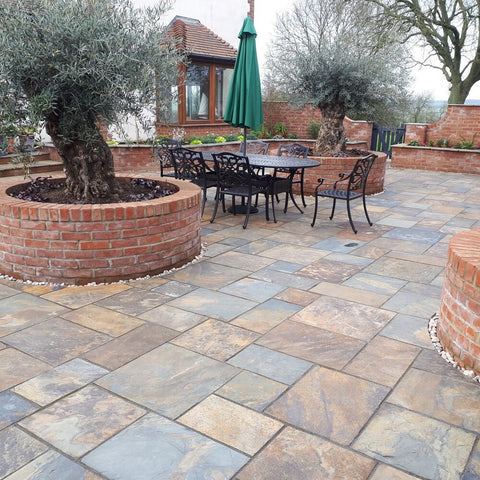
Choosing the right material for your patio and considering the area in which it will be installed are both crucial factors in the planning stage. There are a multitude of materials available, each with its own set of pros and cons, and each offering a unique aesthetic to your outdoor space.
1. Material Selection
The table below outlines some of the most commonly used patio materials:
|
Material |
Costs per square metre for material & install (approx.) |
Advantages |
Disadvantages |
|
Concrete |
£110-135 |
|
|
|
Slate |
£130-180 |
|
|
|
Sandstone or Limestone |
£120-150 |
|
|
|
Porcelain |
£130-180 |
|
|
* - These are estimates only. We attempt to keep this article up to date with pricing, but they are liable to change and are by no means "set in stone".
Area Considerations
When it comes to the area where your patio will be installed, there are several considerations to bear in mind:
Size and Shape: The size of your patio should be proportionate to your home and yard. Additionally, the shape can also affect the overall aesthetic. Curved patios can soften landscapes, while rectangular patios often look more formal.
Sun and Shade: Think about how the sun and shade will hit your patio. You might want to locate your patio in a shady area or include a patio cover or umbrella for those hotter days.
View and Privacy: Consider what you want to see when you're sitting on your patio. Also, consider privacy needs. You might need to include a privacy fence or screen.
Access and Proximity to House: Easy access from your home to your patio is crucial. If you plan to eat meals on the patio, being closer to the kitchen can be a great advantage.
By carefully considering both the material and area, you'll be able to create a patio that not only enhances the beauty of your home but also serves your needs for many years to come.
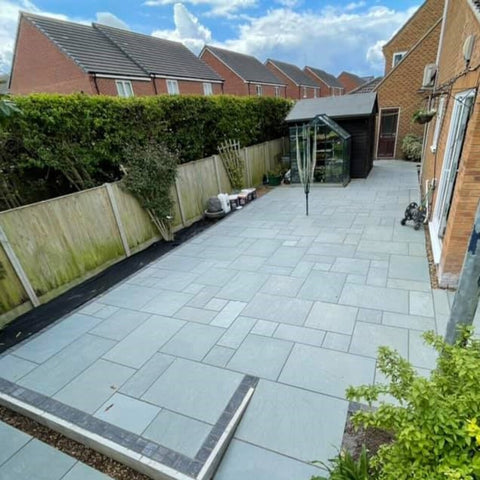
Labor and Other Associated Costs of Patio Installation
When laying a patio, labor costs play a significant role. On average, a landscape gardener may charge between £200-300 per day, and given the physical demands of the task, they typically bring an assistant, which might add another £80-100 to the daily cost. Even when you provide all necessary materials, labor costs can be substantial.
It's essential to note regional cost variations. Labor costs in areas like London could be double those in other parts of the country. Additionally, costs may vary depending on whether you hire an established company or an independent contractor. Lastly, contractors might add a profit margin of 10-20% on top of these costs to cover profit and unexpected expenses.
Understanding labor costs is crucial for two reasons. First, even if you're planning a DIY project, you will likely need an assistant or a willing friend to help you. Second, knowing the professional costs helps you appreciate the savings from your DIY efforts.
Labor Cost For Landscaping - Breakdown
| Labor Type | Cost Per Day |
|---|---|
| Landscape Gardener | £200-£300 |
| Assistant Labourer | £80-£100 |
| Possible Profit Margin | 10-20% of total costs |
Tool and Safety Costs for a DIY Patio Project
A DIY patio project will require specific tools, which could involve renting or purchasing equipment. The following tables outline the potential costs you might incur for tools and safety gear:
Tool Costs For A Garden Makeover - Breakdown
| Tool | Estimated Cost |
|---|---|
| Cement Mixer (Rental) | £15/day |
| Wheelbarrow (Rental) | £10/day |
| Trowel (Purchase) | £20 |
| Rake (Purchase) | £20 |
| Pegs (Purchase) | £5/pack |
| Tape Measure (Purchase) | £20 |
| Spirit Level (Purchase) | £20+ |
| Rubber Mallet (Purchase) | £10 |
Safety Equipment Cost Breakdown
| Safety Equipment | Estimated Cost |
|---|---|
| Knee Pads | £25 |
| Ear Defenders | £25 |
| Steel Toe-capped Workman Boots | £60+ |
| Dust Mask | £10 |
| Rigger Gloves | £10 |
| Safety Goggles | £15 |
Waste Disposal Costs For Landscaping - A Breakdown
Waste disposal is another cost to consider when laying a patio. Skip hire can range from £80 to £300 depending on the project size and waste volume. Although professional landscapers typically handle waste disposal, the cost is usually passed onto the customer, albeit it could be less than managing it yourself due to their access to more cost-effective waste management solutions.
By carefully considering all these costs, you can make an informed decision on whether to hire a professional or tackle the patio project yourself.
Maintenance and Repair Costs of a Patio
Maintenance and repair costs are crucial factors to consider when estimating the total cost of a patio. These costs can vary widely depending on the material used, the climate of your area, and how well the patio is maintained.

Maintenance Cost
Regular maintenance can extend the life of your patio and prevent the need for costly repairs. Depending on the type of patio material, your maintenance might include power washing, sealing, weed control, and regular inspections for signs of damage.
Here's an approximate annual maintenance cost breakdown:
| Maintenance Activity | Estimated Cost |
|---|---|
| Power Washing | £100-£200 |
| Sealing (for some materials like natural stone) | £100-£200 |
| Weed Control | £20-£50 |
| General Cleaning Supplies | £20-£40 |
Repair Costs
Despite your best efforts, there may come a time when you need to repair your patio. Common repairs include replacing cracked pavers or stones, fixing loose joints, or addressing any structural issues. Costs can vary depending on the extent of the damage, but here's an average idea of what you might expect to pay:
| Repair Activity | Estimated Cost |
|---|---|
| Replacing a Single Paver or Stone | £10-£20 plus labor |
| Filling Loose Joints | £20-£40 plus labor |
| Resolving Structural Issues |
£200-£1000+ depending on the severity |
Please note that the prices are subject to the local market rates and the specific requirements of your patio.

Proper Cleaning Techniques for Paving Slabs
Paving slabs are a fantastic choice for any garden, adding aesthetic appeal and functionality. However, to keep your garden looking pristine and welcoming, it's vital to clean these slabs regularly. Prior to cleaning, always ensure to sweep your slabs and test your cleaning solution on a less noticeable section to prevent possible damage.
Here is a tailored guide on the cleaning procedures for common paving slab materials:
| Material | Do's | Don'ts |
|---|---|---|
| Sandstone (More about sandstone paving) | Use a diluted bleach mixture to help kill moss and algae. Be mindful of the bleach quantity to prevent discolouration. | Avoid using cleaning products containing iron. If using a pressure washer, ensure it's on a very low setting. |
| Limestone (See our limestone guide) | Use a pH neutral detergent with warm soapy water. Always test a small area first. | Avoid acidic substances such as lemon or vinegar as they can cause permanent discolouration. |
| Slate (Read about the different types of slate here) | Utilise a pH neutral floor cleaner with warm water only. Opt for a specialist slate cleaning product for the best results and consider a low power pressure washer. | Avoid using a brush with metal wires as it can scratch the slate and compromise the finish. |
| Granite (Learn more about granite paving slabs) | Use a pressure washer to remove accumulated dirt and a specially formulated cleaning mixture for granite. | Refrain from using cleaning solutions with acid or bleach as they can stain the granite. |
Patio Costs: Experts Corner
We have a wealth of experienced landscapers on hand to provide their expertise on all of the subject matters that we write about. We always consult with them to see if they can cast their eye over the information and add any information they may have picked up over the years. Here's what a few of them had to say around patio costs:
Pete Bird - Pete Bird Property Maintenance, Peterborough:
"Set yourself a realistic budget. Many clients have no idea about costs but we need a realistic budget to work to. Also, make a design sketch yourself via online research."
A realistic budget helps a landscaper know what they can offer without going overbudget. A garden that costs £5k could easily be stretched to £20k with everything landscapers can offer, so a budget and a rough sketch to go with it means communication is easier and expectations are managed. A budget is the best guide for design and a reputable company will use that information to help your budget go further, they will not max it out for the sake of it.
Ben Smith - M&B Landscaping, Peterborough:
"Thoroughly check the portfolio of the landscaper you are thinking of hiring. There should be a lot of work to view to get a feel for the kind of finish you are going to get. Also, once you've found the landscaper you like, be prepared to wait for them. Most problems come from those landscapers who were available to start immediately."
Do your research! Good landscapers have lots of examples of their work and are in demand. Patience is key when waiting for your dream space.
Steve Garwell, Dragon Garden Services:
"Always take time to get the groundwork correct as this ensures the patio can last a life time, don't take shortcuts here! The groundwork should be the same regardless of what goes on top, so if the budget can stretch to the best quality slab, then it will be worth it."
The method pushed by TV landscapers called "spot-bedding" or "dot-dab" saves on the cost of the mortar bed, but shortens the lifetime of the patio. Patios should be a permanent fixture, so the extra cost of a fully professional groundwork setup should be a priority.
Travis Speake, Elemental Landscapes, Lincolnshire:
"Access is a major factor when pricing a project. If there is no access for machinery, this would need to be excavated by hand adding another time-factor to the cost."
There are factors like above that it's easy to overlook. Is there access to get a digger into your garden? If not, then be prepared to absorb extra labour cost.
FAQ
Is a patio cheaper than decking?
Decking is cost-effective and fast to install, though its lifespan is shorter. Paving slabs, while costlier and more time-consuming to set up, demand minimal maintenance and have a long-lasting durability. Read our decking vs paving guide for more information.
Does a patio add value to your home?
A patio can enhance the value of a home by extending living space, improving aesthetics, meeting buyer demand, and adding multifunctional outdoor areas. However, the value added varies based on the patio's quality, market demand, and upkeep. Choosing long lasting materials such as natural stone, or outdoor porcelain mean that the patio will add value for a long period of time. Concrete slabs will “perish” after a number of years as the dye used to create their colour expires - limiting the value of the space.
How long does it take to lay a patio?
The time required to lay a patio in the UK depends on several factors, including the size of the area, the type of materials used, ground preparation needs, and weather conditions. On average:
- For a small patio (around 15-20 square metres), it might take 1-3 days.
- For a medium-sized patio (around 40 square metres), it could take 3-5 days.
- Larger patios or those with intricate designs may take a week or more.
Remember, these are approximate durations and can vary based on the complexity of the design, unforeseen challenges, and the expertise of the workers. It's always best to consult with a professional for a specific timeframe.
In Conclusion - The cost of laying a patio
We couldn't possibly cover all elements of the installation if we tried, so we hope we have given you a general overview of how to approach budgeting for your new patio. Now you've got an idea of cost, it's important to remember every company you work with is going to be slightly different, so thoroughly vet them and be prepared to wait if you decide they are the one for your project.

